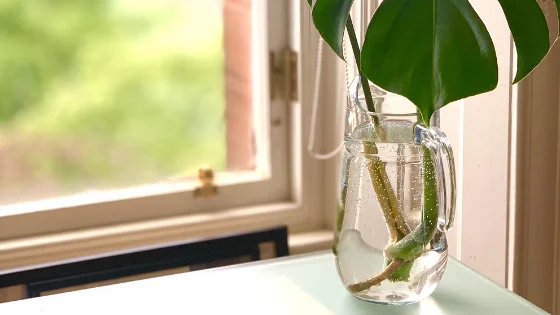Can Monsteras Be Propagated In Water? Hopefully, this article can answer that question for you once and for all. I will go over the method that I use to propagate monsteras in water and answer some frequently asked questions regarding this subject.
In order to successfully root a Monstera in water, you must first find a section of the plant that has a node. Place the cutting in water in a location with bright, indirect light after cutting the plant under the node with sharp scissors. After a few weeks, roots should sprout from the cutting’s tip.
There is much more to this process than what is stated above, but this quick review demonstrates how simple it is to propagate a Monstera in water.
The remainder of this post will go through how to grow a Monstera in water, what to anticipate from a cutting produced this way, and some of the advantages and disadvantages of water propagation.
Read More: Monstera Leaves Care – A Complete Guide
Table of Contents
Can Monsteras Be Propagated In Water?
Water is an excellent medium for growing Monsteras. While there are differing perspectives on the usefulness of this method on the internet, it is equally as successful as soil propagation.
As a bonus, the roots of each cutting are clearly visible as they grow, making it easy to keep track of their development.
Monsteras may also be rooted in soil rather than water, which offers an alternative to water propagation. There isn’t a clear-cut answer when it comes to which strategy is best for plant care.
It’s important to remember that both methods result in rooted cuttings, so keep that in mind while making your choice.
Propagating Monstera Cuttings In Water
A Monstera cutting may be propagated the same way as any other plant cutting. It necessitates the use of the proper instruments as well as the selection of the appropriate plant component to cut.
The procedure is similar to that of growing a Monstera in soil, although there are a few distinctions that I’ll discuss later.
A sharp pair of shears and some form of disinfectant solution, such as rubbing alcohol or diluted bleach, are required if you want to cut into a Monstera.
Before cutting any portion of the plant, sanitize the shears to avoid cross-contamination that might infect your plant with any diseases the scissors may be carrying.
Despite the fact that Monsteras are tough plants, it is never a good idea to bring disease or pests to the plant’s sensitive parts.
You’ll also have to locate a healthy section of the plant from which to take a cutting. Your Monstera may be displayed in water using any section of the plant; however, only cuttings that have at least one node have the potential to sprout roots and ultimately develop into a bigger plant.
Monstera nodes are the sections of the plant that may develop new growth, such as roots and leaves. They’re normally thicker than the remainder of the stem and may sometimes sprout numerous leaves.
Make sure that the portion of Monstera that you choose for a cutting has a lot of robust growth. A healthy plant will not have discolored or diseased leaves, so stay away from them.
Choosing two leaves from the plant is an excellent starting point for propagation of Monstera, however the plant may be propagated from a single leaf and node as well.
Cutting the plant just below its node and placing it in water is all that’s required after that. However, avoid cutting too close. A good place to cut is about a quarter to a half of an inch below the node.
Keep your cuttings in a bright, transparent container. It doesn’t matter what container you use, as long as it is free of contamination. Full-grown Monsteras are tough and resistant to disease, however cuttings are more fragile and more easily damaged.
While transparent glass is preferred, the container’s colour and composition don’t have much of an impact on its popularity. All you have to do is make sure you can see what’s happening on inside so you can keep track of your Monstera’s development.
A somewhat wide opening on whichever container you select is also a good idea: this enhances airflow so that the water the cutting is in does not grow stagnant, and it prevents the roots from being damaged when you’re ready to take it from the glass and plant it in the soil.
It’s preferable not to use tap water while propagating in water. Filtered water is ideal for this procedure since pollutants that might harm the roots have been eliminated.
Rainwater is another fantastic alternative since it typically contains nutrients, like nitrogen, that will help the cuttings grow.
Water Propagation Process:
- Set up a clean workplace and get your tools: all you’ll need are shears, a sanitizing agent, and a container.
- To avoid the spread of disease, thoroughly sanitize all of the tools.
- Decide which portion of the Monstera you want to cut. It must have at least one node and one leaf.
- Cut ¼ to ½ inch below the node with clean shears.
- Fill the container with new water and place the cutting inside.
The Pros of Rooting Monsteras in Water
One of the greatest advantages of rooting your Monstera in water is being able to monitor the progress of the cuttings. This makes detecting possible issues much simpler.
While there isn’t much you can do about a cutting that has started to decay or isn’t taking, being able to see the progress of each cutting will save you from guessing what’s going on.
Observing the growth of your Monstera’s roots is absolutely interesting. Water propagation is a unique approach to grow tropical vines when done in a beautiful container.
“Water roots,” which are white and opaque, are the result of this propagation strategy. The end result is stunning and well worth the time and work.
Furthermore, roots in water eliminates the guesswork associated with caring for fragile cuttings. You don’t need to worry about nutrition, soil, or watering except from cleaning the roots and renewing their water on a regular basis.
Fresh, high-quality water and lots of sunshine are all that are required to keep the cuttings alive. When it comes to caring for cuttings, water propagation is a great option for novices who aren’t sure how to start.
The Cons of Rooting Monsteras in Water
I’ve previously described water roots, but I didn’t go into much depth. Another drawback of water cutting propagation is that the roots form differently than they would in soil.
Water roots are often white and delicate, independent of the plant being propagated. The fragility of Monsteras may be attributed to their rapid root growth and dense roots.
Water roots, however, do not take nutrients and oxygen in the same manner as soil roots do. This makes the move from their natural aquatic environment to a container a little more difficult.
When the cuttings are finally transplanted, it is also possible that they will be shocked. Water propagation may increase the chance of cutting loss since it is a substantial shift for basically fresh plants.
When it comes to how a transplant should be done, there are many different viewpoints. Some recommend using damp moss while others recommend keeping the soil soaking wet for the first few weeks. However, none of these options are really appealing.
Water propagation has never been a concern for me, at least not in my experience. Using this procedure, I have successfully produced many happy, robust Monstera cuttings, as well as other plants, and it has always been my favourite method. There are a lot of other plant owners who have had similar experiences.
When To Move Your Monstera From Water to Soil?
Before moving your Monstera cutting from water to soil, it should have well-developed roots. However, it is impossible to predict how long it will take to reach this position.
It is normally best to transplant Monsteras two or three months after the roots have started to grow in completely, depending on the variety and the climate.
In an ideal situation, the cutting would have a large number of thick, white roots. A tall cutting with numerous leaves should have more roots to sustain it than a smaller one with just a single leaf, so keep that in mind when you cut.
The advantage of all of this is that Monstera cuttings may survive for an extended period of time in water. It’s not ideal, but Monstera cuttings may live for years in water even if they don’t produce much new growth.
Having this much time allows you to make an informed decision about when to transfer the cutting.
It is important to transplant your Monstera cuttings as if you were repotting a mature plant. The plant’s longevity depends on the quality of the soil and the container it’s housed in, so don’t cut corners!
Will Your Monstera Leaf Root?
Despite the fact that you may cut any portion of your Monstera and put it in water, only some areas of the plant are capable of establishing roots.
In the absence of a node, the leaf will not be able to form roots and, thus, will not create new plants. Monstera’s nodes are the component of the plant that can sprout roots and leaves, therefore they’re critical to the process of propagation.
They may be distinguished by their appearance: nodes are significantly thicker sections of the stem that often have multiple foliage and aerial roots sprouting from them.
If you’ve removed leaves from your Monstera that have no nodes, they don’t need to be thrown away. You may use these single leaves to freshen up the interior of your house.
They may be used with flowers or on their own to liven up a room when placed in attractive jars or vases. It’s also possible to employ them in a wide range of applications, from printing to pressing.
Conclusion
Can Monsteras Be Propagated In Water?
My favored way of propagation is by water. It requires no special maintenance. You don’t need to worry about anything other than placing the cuttings in water and checking on them from time to time. Compared to soil cuttings, water cuttings are substantially less time-consuming.
Water propagation is an excellent alternative for novices due to its simplicity of upkeep. Another benefit is that cuttings may be kept in water forever, so you don’t have to worry about when to transplant them.
Don’t be discouraged if you’ve never attempted water propagation before. There is no need to worry about anything. Grab your pruning shears, select a nice location to cut your Monstera, and go to work! You’ll be happy you did.



